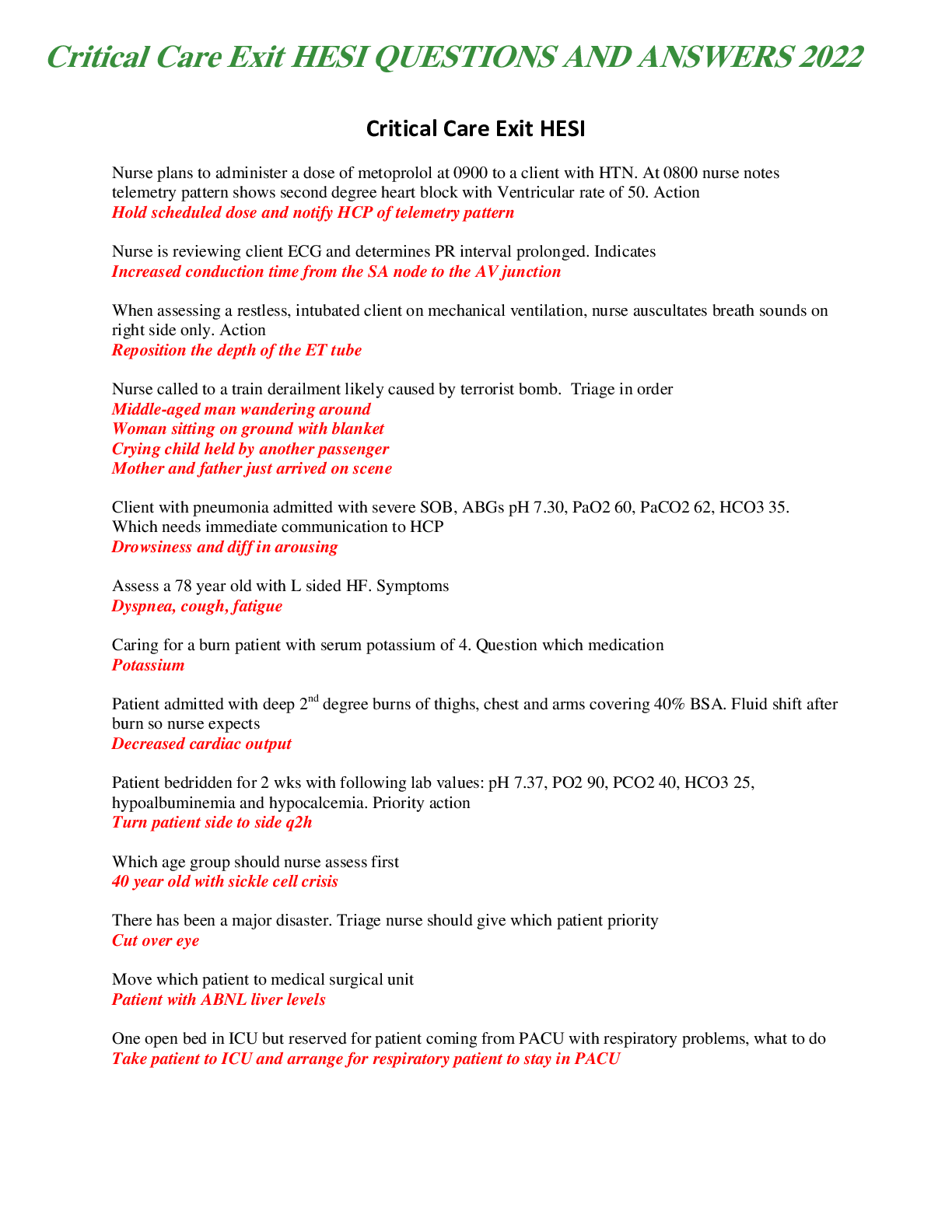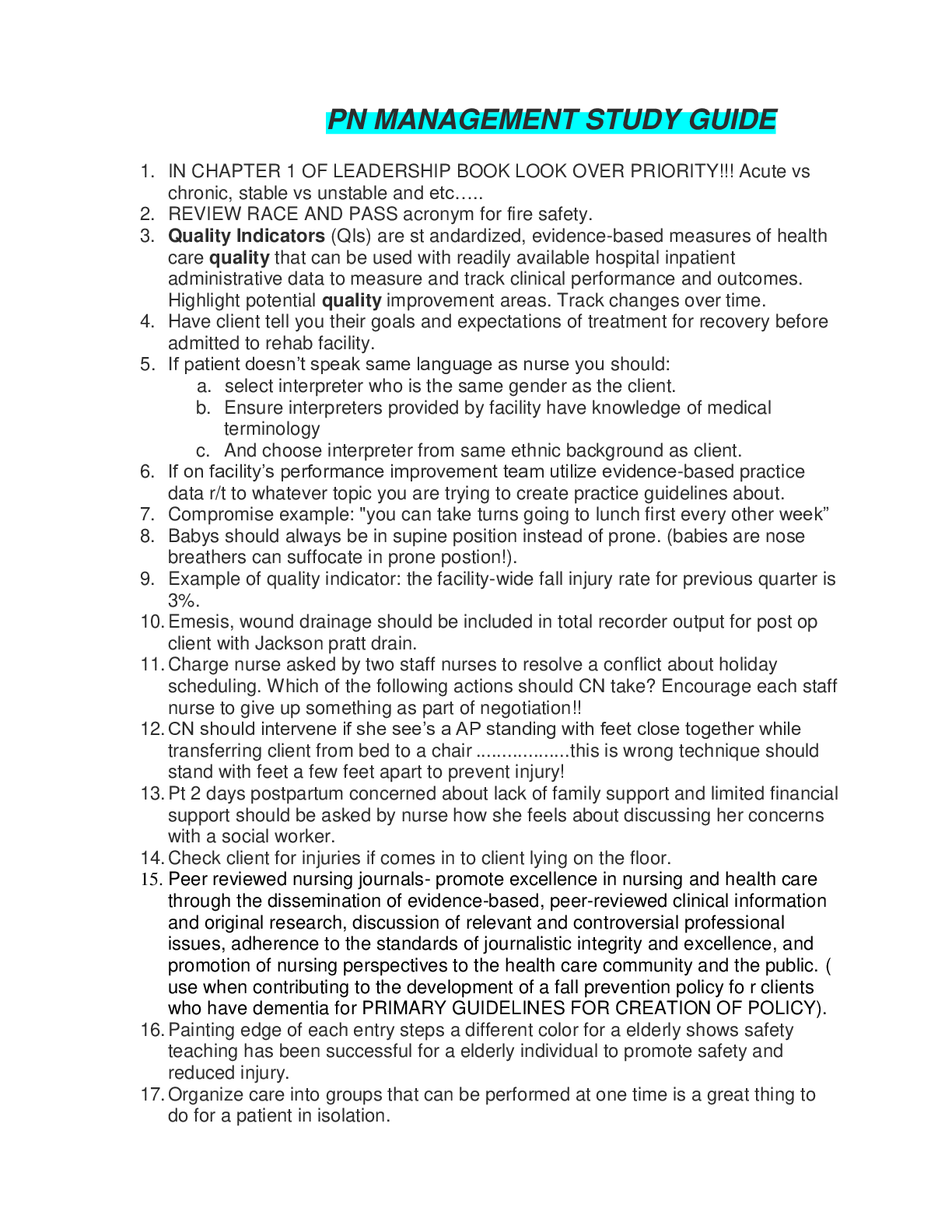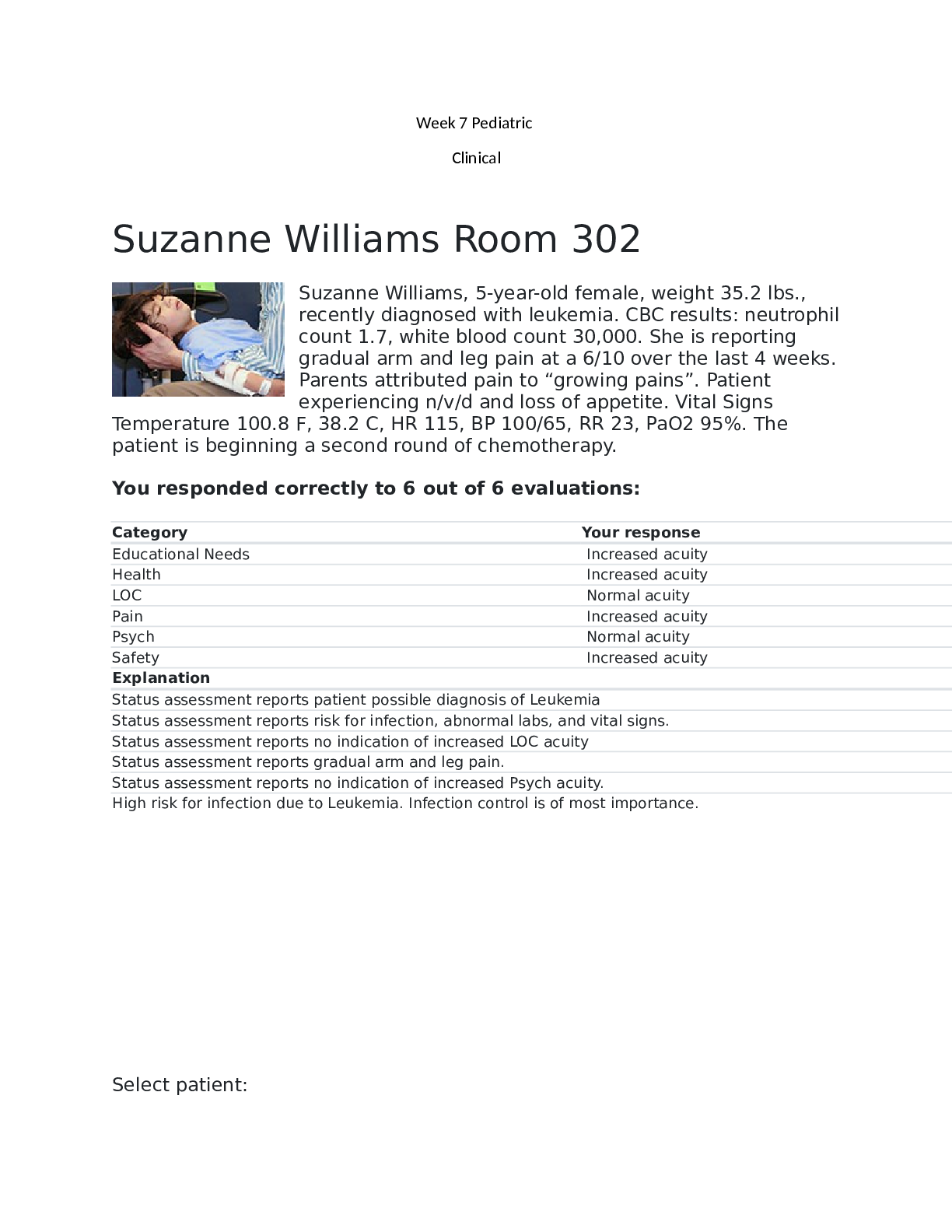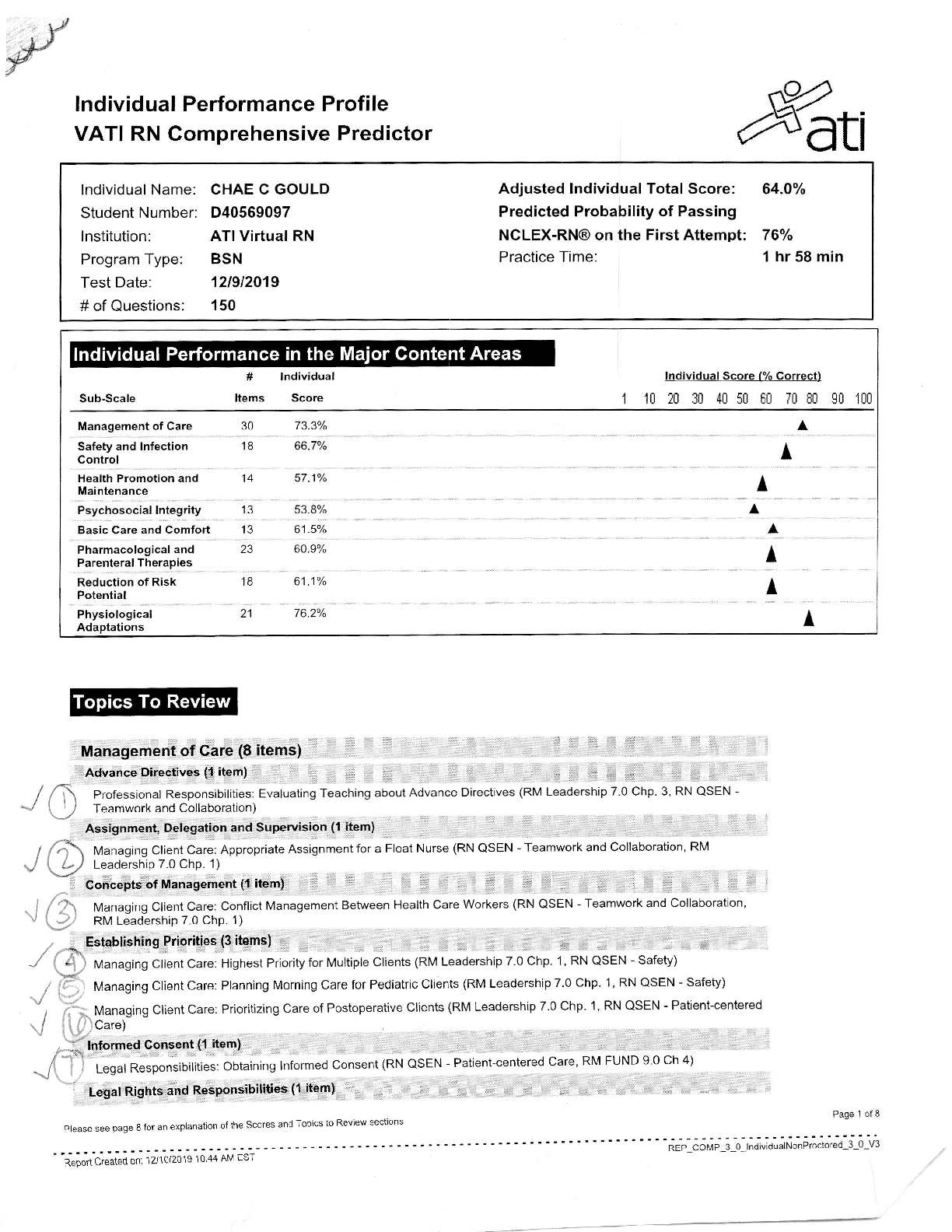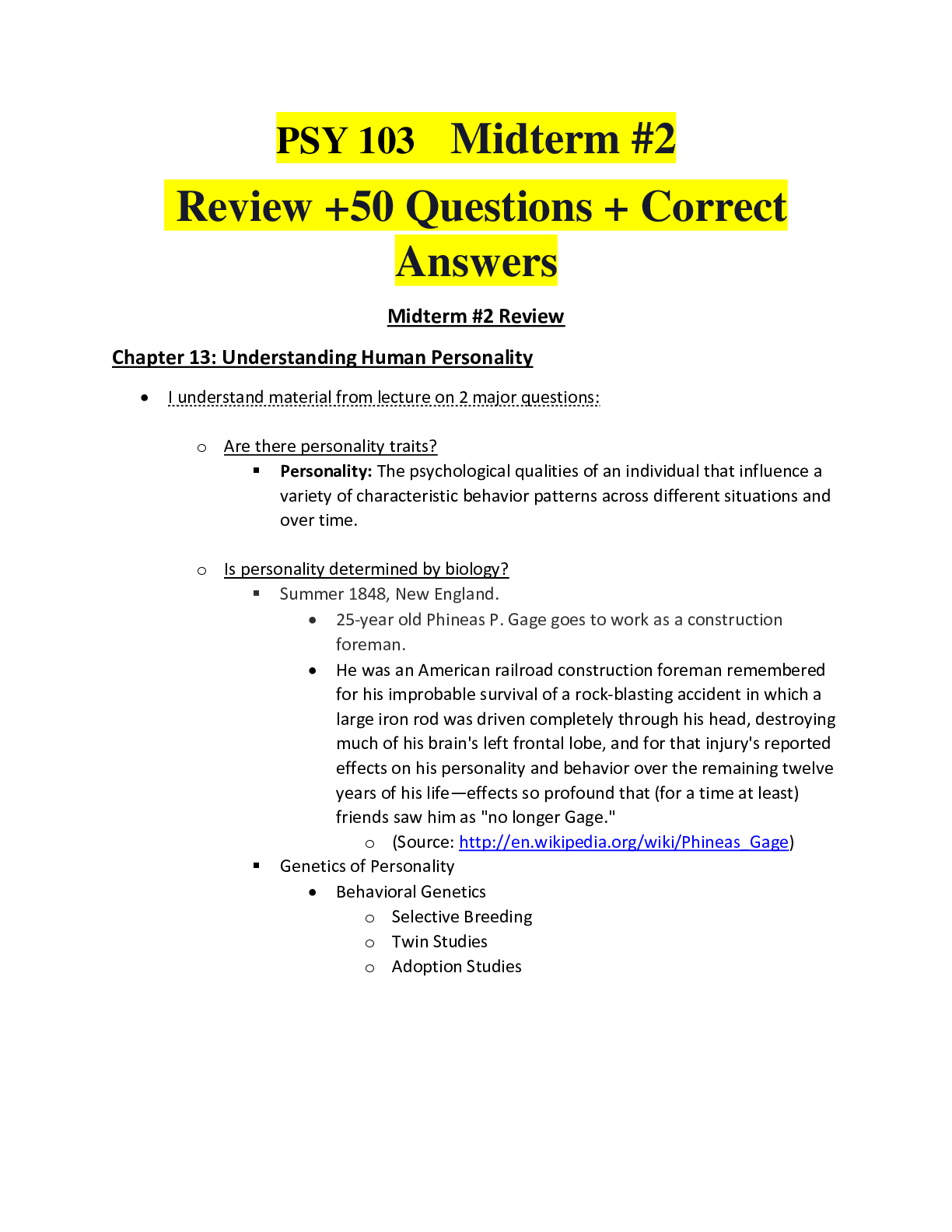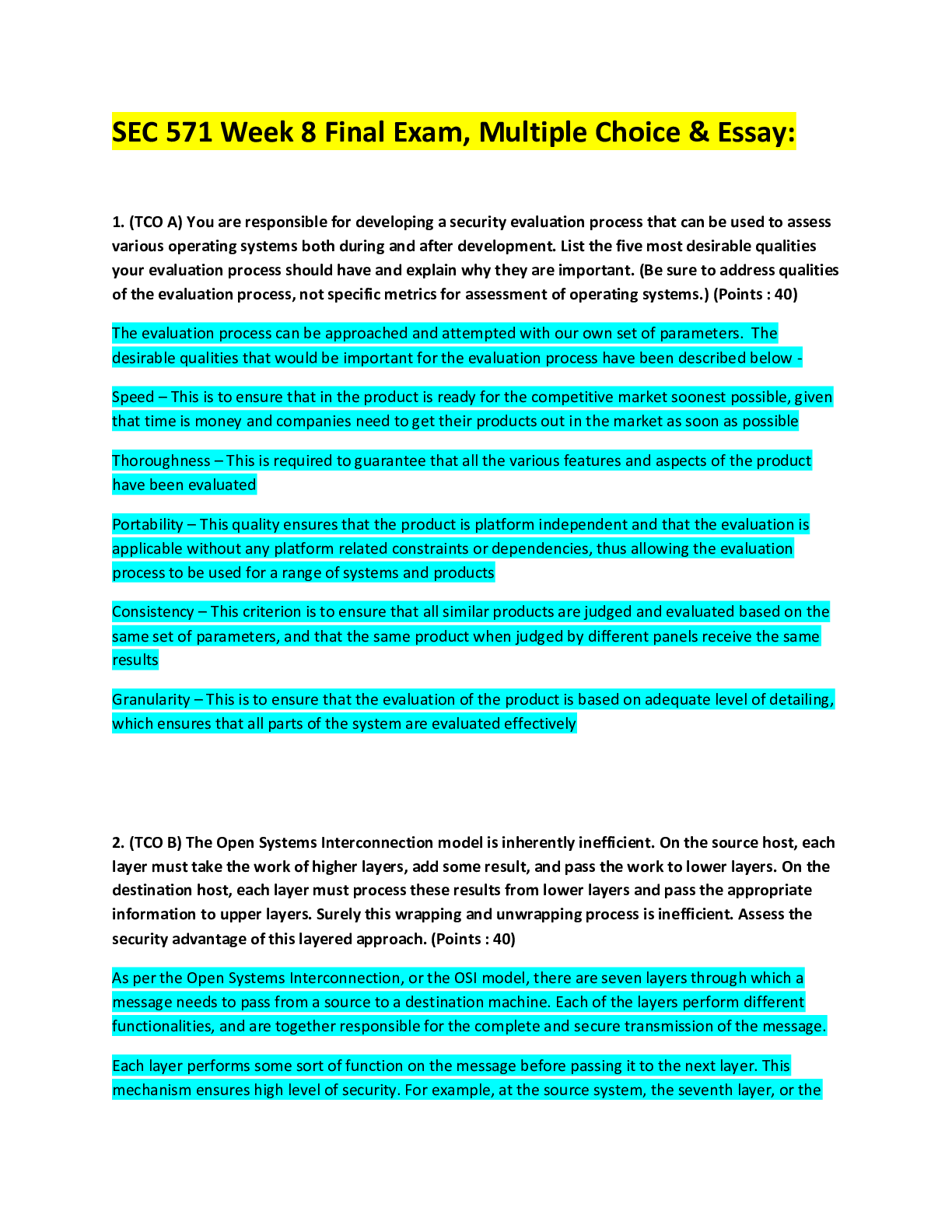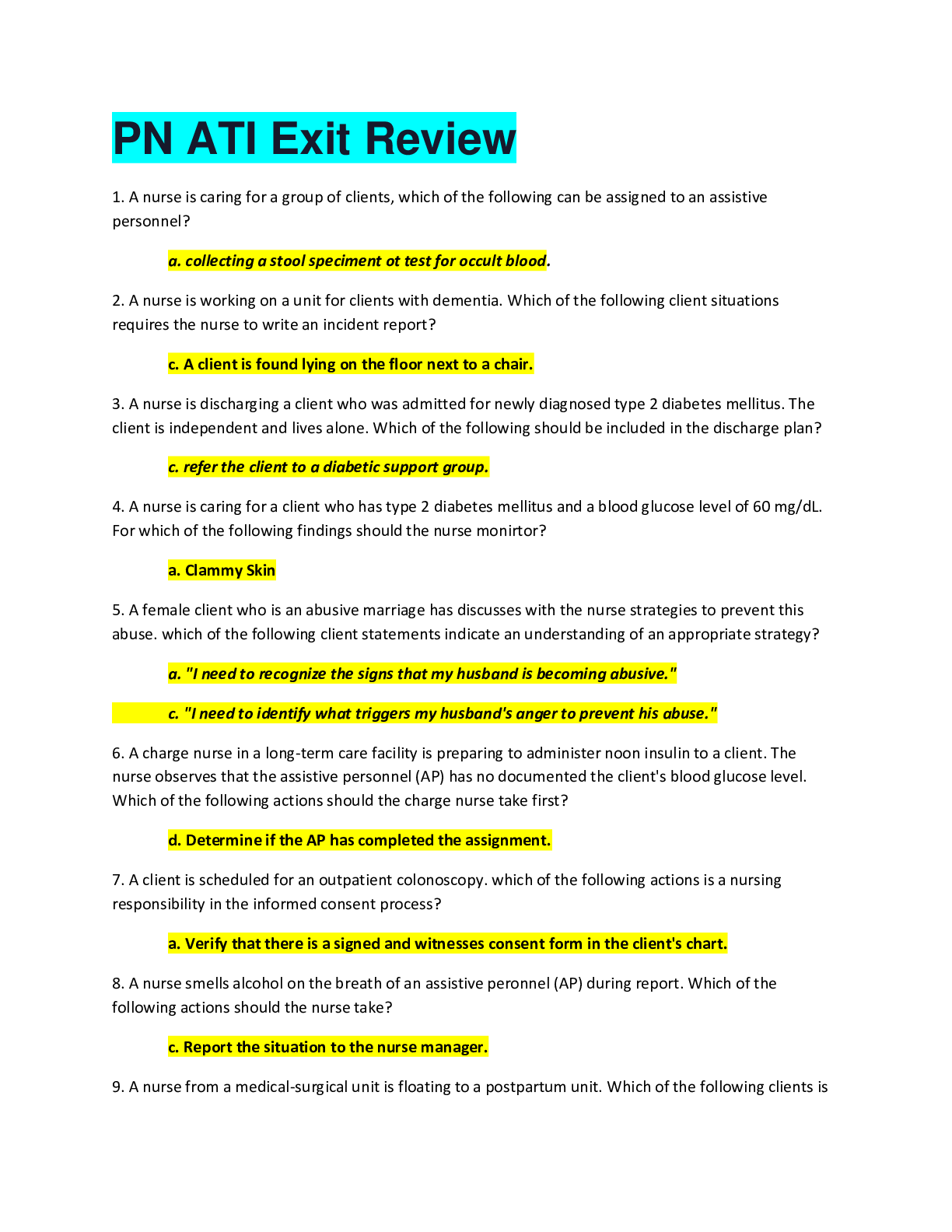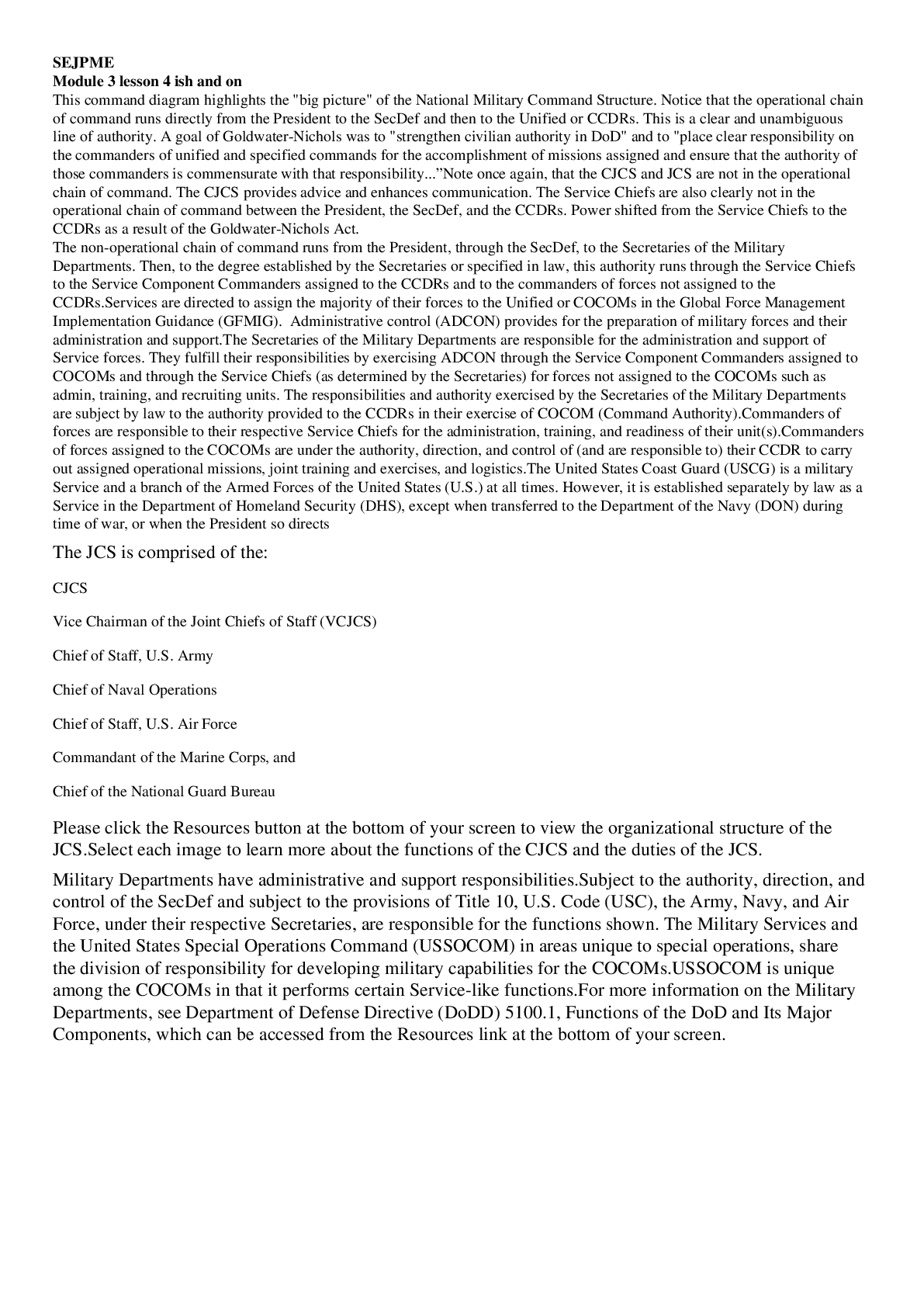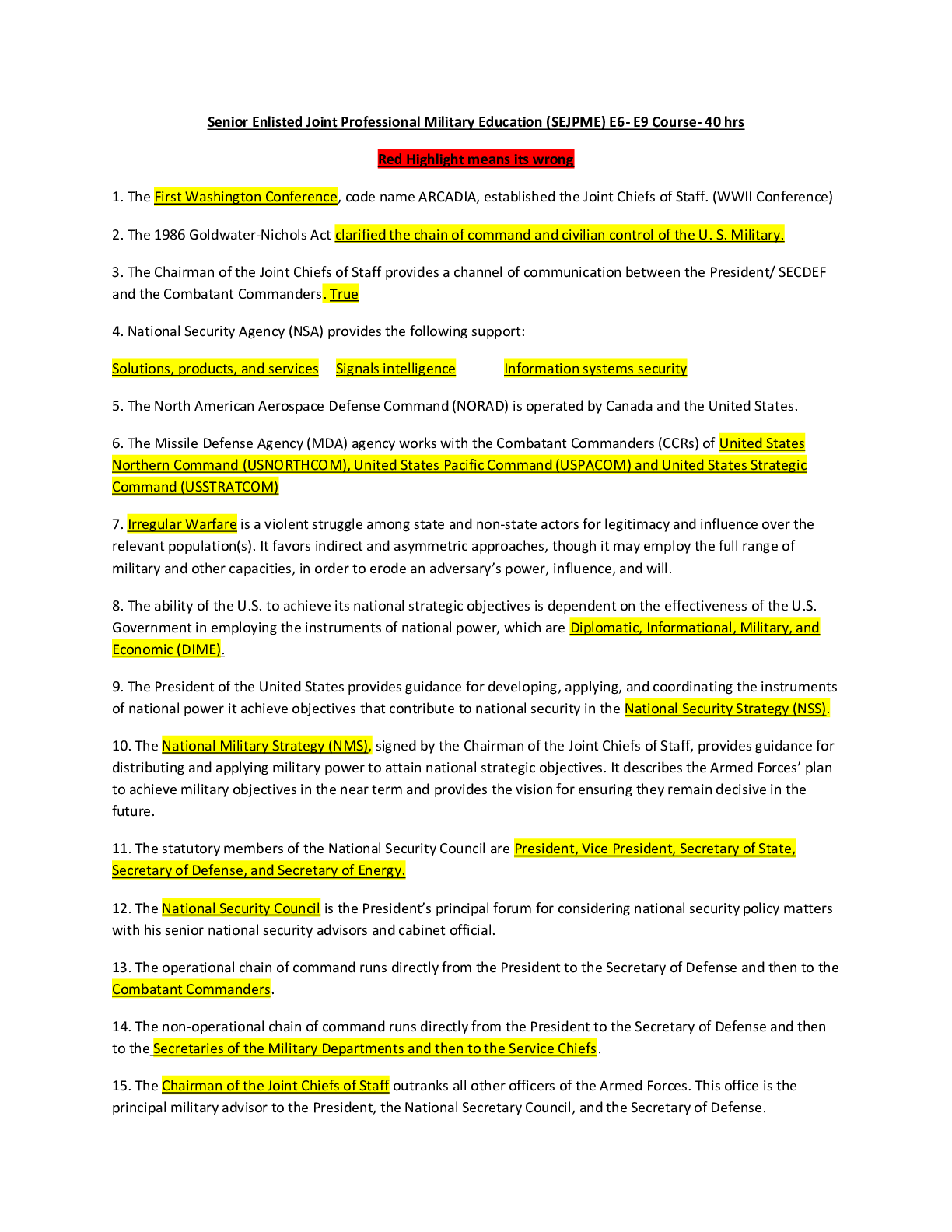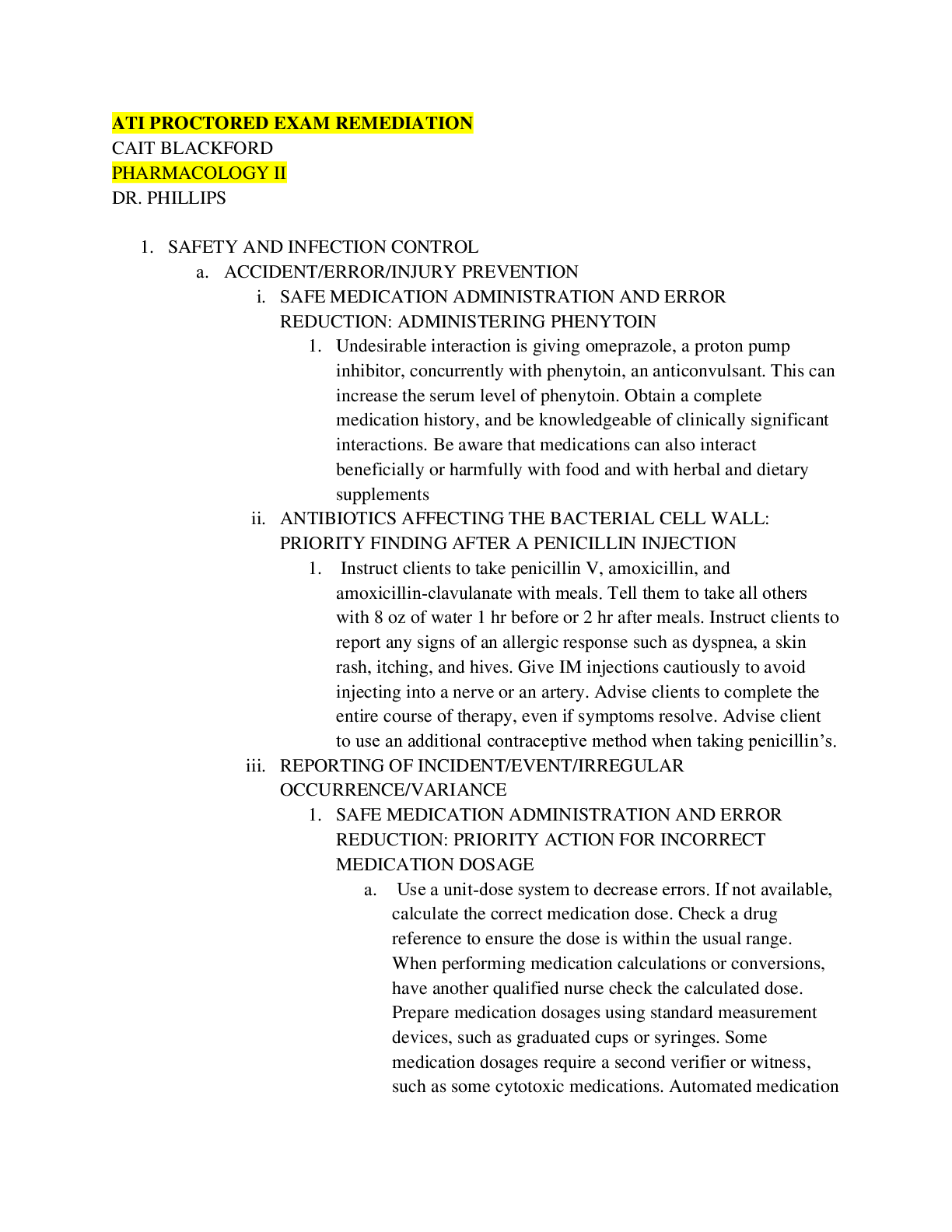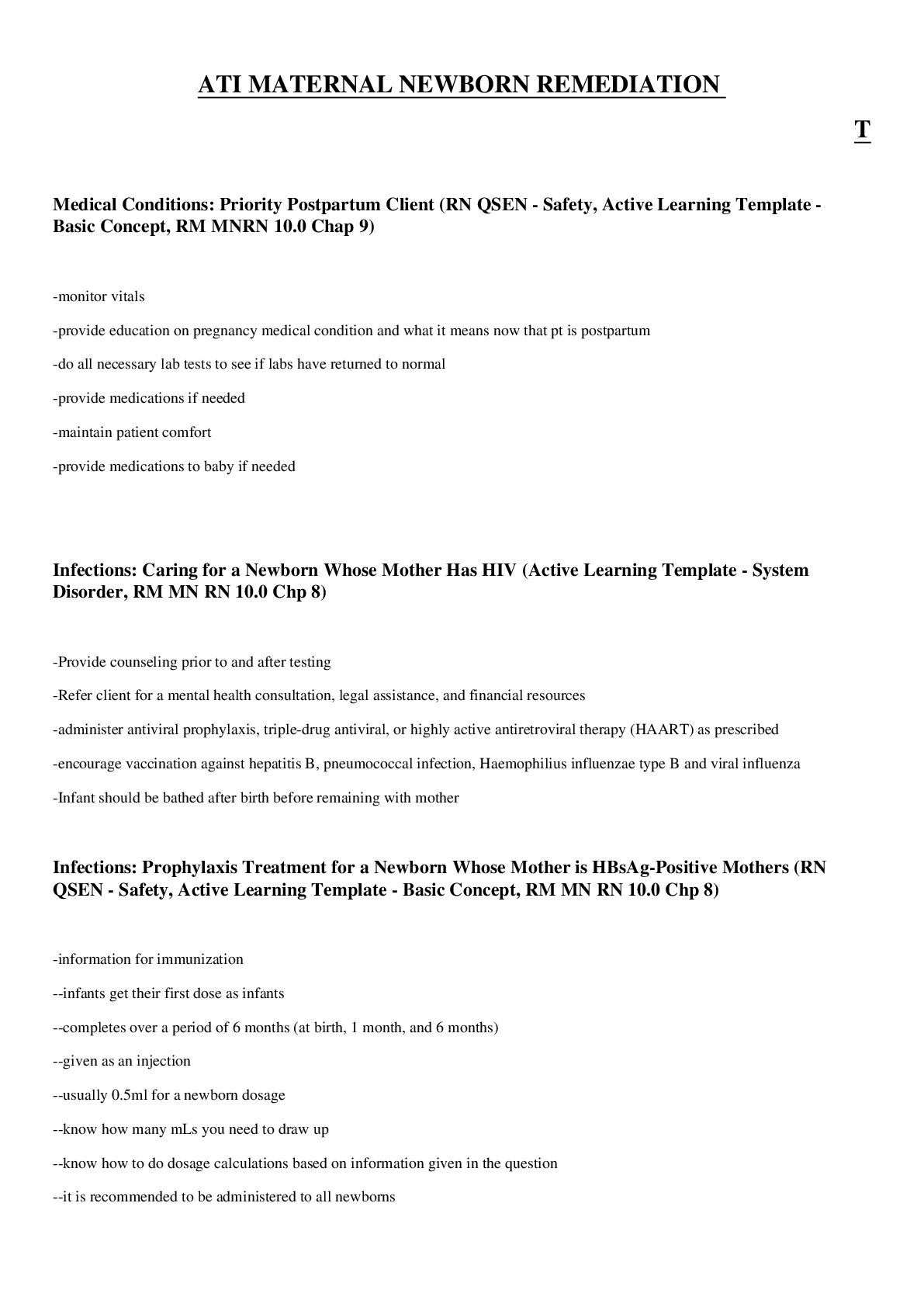*NURSING > STUDY GUIDE > HESI 101-HESI RN FUNDAMENTALS, Latest Complete Solution Guide Rationale, Broward College. (All)
HESI 101-HESI RN FUNDAMENTALS, Latest Complete Solution Guide Rationale, Broward College.
Document Content and Description Below
HESI 101-HESI RN FUNDAMENTALS 1. When turning an immobile bedridden client without assistance, which action by the nurse best ensures client safety? A. Securely grasp the client's arm and leg. B. Put ... bed rails up on the side of bed opposite from the nurse. C. Correctly position and use a turn sheet. D. Lower the head of the client's bed slowly. 2. The nurse identifies a potential for infection in a client with partial-thickness (second-degree) and full-thickness (third-degree) burns. What intervention has the highest priority in decreasing the client's risk of infection? A. Administration of plasma expanders B. Use of careful handwashing technique C. Application of a topical antibacterial cream D. Limiting visitors to the client with burns 3. The nurse is aware that malnutrition is a common problem among clients served by a community health clinic for the homeless. Which laboratory value is the most reliable indicator of chronic protein malnutrition? A. Low serum albumin level B. Low serum transferrin level C. High hemoglobin level D. High cholesterol level 4. In completing a client's preoperative routine, the nurse finds that the operative permit is not signed. The client begins to ask more questions about the surgical procedure. Which action should the nurse take next? A. Witness the client's signature to the permit. B. Answer the client's questions about the surgery. C. Inform the surgeon that the operative permit is not signed and the client has questions about the surgery. D. Reassure the client that the surgeon will answer any questions before the anesthesia is administered. 5. The nurse is assessing several clients prior to surgery. Which factor in a client's history poses the greatest threat for complications to occur during surgery? A. Taking birth control pills for the past 2 years B. Taking anticoagulants for the past year C. Recently completing antibiotic therapy D. Having taken laxatives PRN for the last 6 months 6. When assisting a client from the bed to a chair, which procedure is best for the nurse to follow? A. Place the chair parallel to the bed, with its back toward the head of the bed and assist the client in moving to the chair. B. With the nurse's feet spread apart and knees aligned with the client's knees, stand and pivot the client into the chair. C. Assist the client to a standing position by gently lifting upward, underneath the axillae. D. Stand beside the client, place the client's arms around the nurse's neck, and gently move the client to the chair. 7.Which step(s) should the nurse take when administering ear drops to an adult client? (Select all that apply.) A. Place the client in a side-lying position. B. Pull the auricle upward and outward. C. Hold the dropper 6 cm above the ear canal. D. Place a cotton ball into the inner canal. E. Pull the auricle down and back. 8.The nurse is instructing a client in the proper use of a metered-dose inhaler. Which instruction should the nurse provide the client to ensure the optimal benefits from the drug? A. "Fill your lungs with air through your mouth and then compress the inhaler." B. "Compress the inhaler while slowly breathing in through your mouth." C. "Compress the inhaler while inhaling quickly through your nose." D. "Exhale completely after compressing the inhaler and then inhale." 9. A 20-year-old female client with a noticeable body odor has refused to shower for the last 3 days. She states, "I have been told that it is harmful to bathe during my period." Which action should the nurse take first? A. Accept and document the client's wish to refrain from bathing. B. Offer to give the client a bed bath, avoiding the perineal area. C. Obtain written brochures about menstruation to give to the client. D. Teach the importance of personal hygiene during menstruation with the client. 10. While reviewing the side effects of a newly prescribed medication, a 72-year-old client notes that one of the side effects is a reduction in sexual drive. Which is the best response by the nurse? A. "How will this affect your present sexual activity?" B. "How active is your current sex life?" C. "How has your sex life changed as you have become older?" D. "Tell me about your sexual needs as an older adult." 11. The nurse is using the Glasgow Coma Scale to perform a neurologic assessment. A comatose client winces and pulls away from a painful stimulus. Which action should the nurse take next? A. Document that the client responds to painful stimulus. B. Observe the client's response to verbal stimulation. C. Place the client on seizure precautions for 24 hours. D. Report decorticate posturing to the health care provider. 12. The nurse plans to administer diazepam, 4 mg IV push, to a client with severe anxiety. How many milliliters should the nurse administer? (Round to the nearest tenth.) A. 0.2 mL B. 0.8 mL C. 1.25 mL D. 2.0 mL 13. The nurse prepares to insert a nasogastric tube in a client with hyperemesis who is awake and alert. Which intervention(s) is(are) correct? (Select all that apply.) A. Place the client in a high Fowler position. B. Help the client assume a left side-lying position. C. Measure the tube from the tip of the nose to the umbilicus. D. Instruct the client to swallow after the tube has passed the pharynx. E. Assist the client in extending the neck back so the tube may enter the larynx. 14. The nurse teaches the use of a gait belt to a male caregiver whose wife has right-sided weakness and needs assistance with ambulation. The caregiver performs a return demonstration of the skill. Which observation indicates that the caregiver has learned how to perform this procedure correctly? A. Standing on his wife's strong side, the caregiver is ready to hold the gait belt if any evidence of weakness is observed. B. Standing on his wife's weak side, the caregiver provides security by holding the gait belt from the back. C. Standing behind his wife, the caregiver provides balance by holding both sides of the gait belt. D. Standing slightly in front and to the right of his wife, the caregiver guides her forward by gently pulling on the gait belt. 15. Which nursing diagnosis has the highest priority when planning care for a client with an indwelling urinary catheter?. A. Self-care deficit B. Functional incontinence C. Fluid volume deficit D. High risk for infection 16. A client has a nursing diagnosis of Altered sleep patterns related to nocturia. Which client instruction is important for the nurse to provide? A. Decrease intake of fluids after the evening meal. B. Drink a glass of cranberry juice every day. C. Drink a glass of warm decaffeinated beverage at bedtime. D. Consult the health care provider about a sleeping pill. 17. When performing sterile wound care in the acute care setting, the nurse obtains a bottle of normal saline from the bedside table that is labeled "opened" and dated 48 hours prior to the current date. Which is the best action for the nurse to take? A. Use the normal saline solution once more and then discard. B. Obtain a new sterile syringe to draw up the labeled saline solution. C. Use the saline solution and then relabel the bottle with the current date. D. Discard the saline solution and obtain a new unopened bottle. 18. Based on the nursing diagnosis of risk for infection, which intervention is best for the nurse to implement when providing care for an older incontinent client? A. Maintain standard precautions. B. Initiate contact isolation measures. C. Insert an indwelling urinary catheter. D. Instruct client in the use of adult diapers. . 19. When taking a client's blood pressure, the nurse is unable to distinguish the point at which the first sound was heard. Which is the best action for the nurse to take? A. Deflate the cuff completely and immediately reattempt the reading. B. Reinflate the cuff completely and leave it inflated for 90 to 110 seconds before taking the second reading. C. Deflate the cuff to zero and wait 30 to 60 seconds before reattempting the reading. D. Document the exact level visualized on the sphygmomanometer where the first fluctuation was seen. 20. A client's blood pressure reading is 156/94 mm Hg. Which action should the nurse take first? A. Tell the client that the blood pressure is high and that the reading needs to be verified by another nurse. B. Contact the health care provider to report the reading and obtain a prescription for an antihypertensive medication. C. Replace the cuff with a larger one to ensure an ample fit for the client to increase arm comfort. D. Compare the current reading with the client's previously documented blood pressure readings. 21. A nurse stops at a motor vehicle collision site to render aid until the emergency personnel arrive and applies pressure to a groin wound that is bleeding profusely. Later the client has to have the leg amputated and sues the nurse for malpractice. Which is the most likely outcome of this lawsuit? A. The Patient's Bill of Rights protects clients from malicious intents, so the nurse could lose the case. B. The lawsuit may be settled out of court, but the nurse's license is likely to be revoked. C. There will be no judgment against the nurse, whose actions were protected under the Good Samaritan Act. D. The client will win because the four elements of negligence (duty, breach, causation, and damages) can be proved. . 22. When the health care provider diagnoses metastatic cancer and recommends a gastrostomy for an older female client in stable condition, the son tells the nurse that his mother must not be told the reason for the surgery because she "can't handle" the cancer diagnosis. Which legal principle is the court most likely to uphold regarding this client's right to informed consent? A. The family can provide the consent required in this situation because the older adult is in no condition to make such decisions. B. Because the client is mentally incompetent, the son has the right to waive informed consent for her. C. The court will allow the health care provider to make the decision to withhold informed consent under therapeutic privilege. D. If informed consent is withheld from a client, health care providers could be found guilty of negligence. 23. The nurse is obtaining a lie-sit-stand blood pressure reading on a client. Which action is most important for the nurse to implement? A. Stay with the client while the client is standing. B. Record the findings on the graphic sheet in the chart. C. Keep the blood pressure cuff on the same arm. D. Record changes in the client's pulse rate. 24. A client becomes angry while waiting for a supervised break to smoke a cigarette outside and states, "I want to go outside now and smoke. It takes forever to get anything done here!" Which intervention is best for the nurse to implement? A. Encourage the client to use a nicotine patch. B. Reassure the client that it is almost time for another break. C. Have the client leave the unit with another staff member. D. Review the schedule of outdoor breaks with the client. 25. Which serum laboratory value should the nurse monitor carefully for a client who has a nasogastric (NG) tube to suction for the past week? A. White blood cell count B. Albumin C. Calcium D. Sodium 26. A female client with frequent urinary tract infections (UTIs) asks the nurse to explain her friend's advice about drinking a glass of juice daily to prevent future UTIs. Which response is best for the nurse to provide? A. Orange juice has vitamin C that deters bacterial growth. B. Apple juice is the most useful in acidifying the urine. C. Cranberry juice stops pathogens' adherence to the bladder. D. Grapefruit juice increases absorption of most antibiotics. 27.The nurse is counting a client's respiratory rate. During a 30-second interval, the nurse counts six respirations and the client coughs three times. In repeating the count for a second 30-second interval, the nurse counts eight respirations. Which respiratory rate should the nurse document? A. 14 B. 16 C. 17 D. 28 28. The nurse is teaching an obese client, newly diagnosed with arteriosclerosis, about reducing the risk of a heart attack or stroke. Which health promotion brochure is most important for the nurse to provide to this client? A. "Monitoring Your Blood Pressure at Home" B. "Smoking Cessation as a Lifelong Commitment" C. "Decreasing Cholesterol Levels Through Diet" D. "Stress Management for a Healthier You" 29. The nurse finds a client crying behind a locked bathroom door. The client will not open the door. Which action should the nurse implement first? A. Instruct an unlicensed assistive personnel (UAP) to stay and keep talking to the client. B. Sit quietly in the client's room until the client leaves the bathroom. C. Allow the client to cry alone and leave the client in the bathroom. D. Talk to the client and attempt to find out why the client is crying. 30. A client in a long-term care facility reports to the nurse that he has not had a bowel movement in 2 days. Which intervention should the nurse implement first? A. Instruct the caregiver to offer a glass of warm prune juice at mealtimes. B. Notify the health care provider and request a prescription for a large-volume enema. C. Assess the client's medical record to determine the client's normal bowel pattern. D. Instruct the caregiver to increase the client's fluids top five 8-ounce glasses per day. A. Take a vitamin supplement tablet once a day. B. Change positions in the chair at least every hour. C. Increase daily intake of water or other oral fluids. D. Purchase a newer model wheelchair. 32. Urinary catheterization is prescribed for a postoperative female client who has been unable to void for 8 hours. The nurse inserts the catheter, but no urine is seen in the tubing. Which action will the nurse take next? A. Clamp the catheter and recheck it in 60 minutes. B. Pull the catheter back 3 inches and redirect upward. C. Leave the catheter in place and reattempt with another catheter. D. Notify the health care provider of a possible obstruction. 33. The mental health nurse plans to discuss a client's depression with the health care provider in the emergency department. There are two clients sitting across from the emergency department desk. Which nursing action is best? A. Only refer to the client by gender. B. Identify the client only by age. C. Avoid using the client's name. D. Discuss the client another time. . 34.The nurse is teaching a client how to perform progressive muscle relaxation techniques to relieve insomnia. A week later the client reports that he is still unable to sleep, despite following the same routine every night. Which action should the nurse take first? A. Instruct the client to add regular exercise as a daily routine. B. Determine if the client has been keeping a sleep diary. C. Encourage the client to continue the routine until sleep is achieved. D. Ask the client to describe the routine he is currently following. 35. Ten minutes after signing an operative permit for a fractured hip, an older client states, "The aliens will be coming to get me soon!" and falls asleep. Which action should the nurse implement next? A. Make the client comfortable and allow the client to sleep. B. Assess the client's neurologic status. C. Notify the surgeon about the comment. D. Ask the client's family to co-sign the operative permit. 36. A nurse is working in an occupational health clinic when an employee walks in and states that he was struck by lightning while working in a truck bed. The client is alert but reports feeling faint. Which assessment will the nurse perform first? A. Pulse characteristics B. Open airway C. Entrance and exit wounds D. Cervical spine injury 37. The nurse who is preparing to give an adolescent client a prescribed antipsychotic medication notes that parental consent has not been obtained. Which action should the nurse take? A. Review the chart for a signed consent for hospitalization. B. Get the health care provider's permission to give the medication. C. Do not give the medication and document the reason. D. Complete an incident report and notify the parents. 38.A hospitalized client has had difficulty falling asleep for two nights and is becoming irritable and restless. Which action by the nurse is best? A. Determine the client's usual bedtime routine and include these rituals in the plan of care as safety allows. B. Instruct the UAP not to wake the client under any circumstances during the night. C. Place a "Do Not Disturb" sign on the door and change assessments from every 4 to every 8 hours. D. Encourage the client to avoid pain medication during the day, which might increase daytime napping. 39. The nurse is assisting a client to the bathroom. When the client is 5 feet from the bathroom door, he states, "I feel faint." Before the nurse can get the client to a chair, the client starts to fall. Which is the priority action for the nurse to take? A. Check the client's carotid pulse. B. Encourage the client to get to the toilet. C. In a loud voice, call for help. D. Gently lower the client to the floor. 40. A male client is laughing at a television program with his wife when the evening nurse enters the room. He says his foot is hurting and he would like a pain pill. How should the nurse respond? A. Ask him to rate his pain on a scale of 1 to 10. B. Encourage him to wait until bedtime so the pill can help him sleep. C. Attend to an acutely ill client's needs first because this client is laughing. D. Instruct him in the use of deep breathing exercises for pain control. 41. During a routine assessment, an obese 50-year-old female client expresses concern about her sexual relationship with her husband. Which is the best response by the nurse? A. Reassure the client that many obese people have concerns about sex. B. Remind the client that sexual relationships need not be affected by obesity. C. Determine the frequency of sexual intercourse. D. Ask the client to talk about specific concerns. 42.The nurse determines that a postoperative client's respiratory rate has increased from 18 to 24 breaths/min. Based on this assessment finding, which intervention is most important for the nurse to implement? A. Encourage the client to increase ambulation in the room. B. Offer the client a high-carbohydrate snack for energy. C. Force fluids to thin the client's pulmonary secretions. D. Determine if pain is causing the client's tachypnea. 43. A nurse is assigned to care for a close friend in the hospital setting. Which action should the nurse take first when given the assignment? A. Notify the friend that all medical information will be kept confidential. B. Explain the relationship to the charge nurse and ask for reassignment. C. Approach the client and ask if the assignment is uncomfortable. D. Accept the assignment but protect the client's confidentiality. 44. The nurse-manager of a skilled nursing (chronic care) unit is instructing UAPs on ways to prevent complications of immobility. Which intervention should be included in this instruction? A. Perform range-of-motion exercises to prevent contractures. B. Decrease the client's fluid intake to prevent diarrhea. C. Massage the client's legs to reduce embolism occurrence. D. Turn the client from side to back every shift. 45. The nurse is preparing an older client for discharge. Which method is best for the nurse to use when evaluating the client's ability to perform a dressing change at home? A. Determine how the client feels about changing the dressing. B. Ask the client to describe the procedure in writing. C. Seek a family member's evaluation of the client's ability to change the dressing. D. Observe the client change the dressing unassisted. 46.The nurse is instructing a client with cholecystitis regarding diet choices. Which meal best meets the dietary needs of this client? A. Steak, baked beans, and a salad B. Broiled fish, green beans, and an apple C. Pork chops, macaroni and cheese, and grapes D. Avocado salad, milk, and angel food cake 47. When bathing an uncircumcised boy older than 3 years, which action should the nurse take? A. Remind the child to clean his genital area. B. Defer perineal care because of the child's age. C. Retract the foreskin gently to cleanse the penis. D. Ask the parents why the child is not circumcised. 48. The health care provider has changed a client's prescription from the PO to the IV route of administration. The nurse should anticipate which change in the pharmacokinetic properties of the medication? A. The client will experience increased tolerance to the drug's effects and may need a higher dose. B. The onset of action of the drug will occur more rapidly, resulting in a more rapid effect. C. The medication will be more highly protein-bound, increasing the duration of action. D. The therapeutic index will be increased, placing the client at greater risk for toxicity. 49. An older client who had abdominal surgery 3 days earlier was given a barbiturate for sleep and is now requesting to go to the bathroom. Which action should the nurse implement? A. Assist the client to walk to the bathroom and do not leave the client alone. B. Request that the UAP assist the client onto a bedpan. C. Ask if the client needs to have a bowel movement or void. D. Assess the client's bladder to determine if the client needs to urinate. 50. By rolling contaminated gloves inside-out, the nurse is affecting which step in the chain of infection? A. Mode of transmission B. Portal of entry C. Reservoir D. Portal of exit 51. Which instruction is most important for the nurse to include when teaching a client with limited mobility strategies to prevent venous thrombosis? A. Perform cough and deep breathing exercises hourly. B. Turn from side to side in bed at least every 2 hours. C. Dorsiflex and plantarflex the feet 10 times each hour. D. Drink approximately 4 ounces of water every hour. 52. In assisting an older adult client prepare to take a tub bath, which nursing action is most important? A. Check the bath water temperature. B. Shut the bathroom door. C. Ensure that the client has voided. D. Provide extra towels. 53. In taking a client's history, the nurse asks about the stool characteristics. Which description should the nurse report to the health care provider as soon as possible? A. Daily black, sticky stool B. Daily dark brown stool C. Firm brown stool every other day D. Soft light brown stool twice a day 54. After the nurse tells an older client that an IV line needs to be inserted, the client becomes very apprehensive, loudly verbalizing a dislike for all health care providers and nurses. How should the nurse respond? A. Ask the client to remain quiet so the procedure can be performed safely. B. Concentrate on completing the insertion as efficiently as possible. C. Calmly reassure the client that the discomfort will be temporary. D. Tell the client a joke as a means of distraction from the procedure. 55. One week after being told that she has terminal cancer with a life expectancy of 3 weeks, a female client tells the nurse, "I think I will plan a big party for all my friends." How should the nurse respond? A. "You may not have enough energy before long to hold a big party." B. "Do you mean to say that you want to plan your funeral and wake?" C. "Planning a party and thinking about all your friends sounds like fun." D. "You should be thinking about spending your last days with your family." 56. The nurse observes a UAP taking a client's blood pressure in the lower extremity. Which observation of this procedure requires the nurse's intervention? A. The cuff wraps around the girth of the leg. B. The UAP auscultates the popliteal pulse with the cuff on the lower leg. C. The client is placed in a prone position. D. The systolic reading is 20 mm Hg higher than the blood pressure in the client's arm. 57. During a clinic visit, the mother of a 7-year-old reports to the nurse that her child is often awake until midnight playing and is then very difficult to awaken in the morning for school. Which assessment data should the nurse obtain in response to the mother's report? A. The occurrence of any episodes of sleep apnea B. The child's blood pressure, pulse, and respirations C. Length of rapid eye movement (REM) sleep that the child is experiencing D. Description of the family's home environment . 58. The nurse assesses a 2-year-old who is admitted for dehydration and finds that the peripheral IV rate by gravity has slowed, even though the venous access site is healthy. What should the nurse do next? A. Apply a warm compress proximal to the site. B. Check for kinks in the tubing and raise the IV pole. C. Adjust the tape that stabilizes the needle. D. Flush with normal saline and recount the drop rate. 59. Which client is most likely to be at risk for spiritual distress? A. Roman Catholic woman considering an abortion B. Jewish man considering hospice care for his wife C. Seventh-Day Adventist who needs a blood transfusion D. Muslim man who needs a total knee replacement 60. Which intervention is most important to include in the plan of care for a client at high risk for the development of postoperative thrombus formation? A. Instruct in the use of the incentive spirometer. B. Elevate the head of the bed during all meals. C. Use aseptic technique to change the dressing. D. Encourage frequent ambulation in the hallway. 61. Which nonverbal action should the nurse implement to demonstrate active listening? A. Sit facing the client. B. Cross arms and legs. C. Avoid eye contact. D. Lean back in the chair. 62. A seriously ill female client tells the nurse, "I am so tired and in so much pain! Please help me to die." Which is the best response for the nurse to provide? A. Administer the prescribed maximum dose of pain medication. B. Talk with the client about her feelings related to her own death. C. Collaborate with the health care provider about initiating antidepressant therapy. D. Refer the client to the ethics committee of her local health care facility. 63. A community hospital is opening a mental health services department. Which document should the nurse use to develop the unit's nursing guidelines? A. Americans with Disabilities Act of 1990 B. ANA Code of Ethics with Interpretative Statements C. ANA's Scope and Standards of Nursing Practice D. Patient's Bill of Rights of 1990 64. While conducting an intake assessment of an adult male at a community mental health clinic, the nurse notes that his affect is flat, he responds to questions with short answers, and he reports problems with sleeping. He reports that his life partner recently died from pneumonia. Which action is most important for the nurse to implement? A. Encourage the client to see the clinic's grief counselor. B. Determine if the client has a family history of suicide attempts. C. Inquire about whether the life partner was suffering from AIDS. D. Consult with the health care provider about the client's need for antidepressant medications. 65. An older adult who recently began self-administration of insulin calls the nurse daily to review the steps that should be taken when giving an injection. The nurse has assessed the client's skills during two previous office visits and knows that the client is capable of giving the daily injection. Which response by the nurse is likely to be most helpful in encouraging the client to assume total responsibility for the daily injections? A. "I know you are capable of giving yourself the insulin." B. "Giving yourself the injection seems to make you nervous." C. "When I watched you give yourself the injection, you did it correctly." D. "Tell me what you want me to do to help you give yourself the injection at home." 66. After receiving written and verbal instructions from a clinic nurse about a newly prescribed medication, a client asks the nurse what to do if questions arise about the medication after getting home. How should the nurse respond? A. Provide the client with a list of Internet sites that answer frequently asked questions about medications. B. Advise the client to obtain a current edition of a drug reference book from a local bookstore or library. C. Reassure the client that information about the medication is included in the written instructions. D. Encourage the client to call the clinic nurse or health care provider if any questions arise. A. Assign an unlicensed assistive personnel to transport the client via a wheelchair. B. Remind the client to walk carefully down the stairs until reaching a lower floor. C. Ask the client to help by assisting a wheelchair-bound client to a nearby elevator. D. Open the closest fire doors so that ambulatory clients can evacuate more rapidly. 68. After a needle stick occurs while removing the cap from a sterile needle, which action should the nurse implement? A. Complete an incident report. B. Select another sterile needle. C. Disinfect the needle with an alcohol swab. D. Notify the supervisor of the department immediately. 69. When emptying 350 mL of pale yellow urine from a client's urinal, the nurse notes that this is the first time the client has voided in 4 hours. Which action should the nurse take next? A. Record the amount on the client's fluid output record. B. Encourage the client to increase oral fluid intake. C. Notify the health care provider of the findings. D. Palpate the client's bladder for distention. A. Dilute each of the medications with sterile water prior to administration. B. Mix the medications in one syringe before opening the feeding tube. C. Administer water between the doses of the two liquid medications. D. Withdraw any fluid from the tube before instilling each medication. 71. The nurse transcribes the postoperative prescriptions for a client who returns to the unit following surgery and notes that an antihypertensive medication that was prescribed preoperatively is not listed. Which action should the nurse take? A. Consult with the pharmacist about the need to continue the medication. B. Administer the antihypertensive medication as prescribed preoperatively. C. Withhold the medication until the client is fully alert and vital signs are stable. D. Contact the health care provider to renew the prescription for the medication. 72. A client has a nasogastric tube connected to low intermittent suction. When administering medications through the nasogastric tube, which action should the nurse do first? A. Clamp the nasogastric tube. B. Confirm placement of the tube. C. Use a syringe to instill the medications. D. Turn off the intermittent suction device. 73. The nurse selects the best site for insertion of an IV catheter in the client's right arm. Which documentation should the nurse use to identify placement of the IV access? A. Left brachial vein B. Right cephalic vein C. Dorsal side of the right wrist D. Right upper extremity 74. The nurse is administering the 0900 medications to a client who was admitted during the night. Which client statement indicates that the nurse should further assess the medication order? A. "At home I take my pills at 8:00 am." B. "It costs a lot of money to buy all of these pills." C. "I get so tired of taking pills every day." D. "This is a new pill I have never taken before." 75. Which action should the nurse implement when providing wound care instructions to a client who does not speak English? A. Ask an interpreter to provide wound care instructions. B. Speak directly to the client, with an interpreter translating. C. Request the accompanying family member to translate. D. Instruct a bilingual employee to read the instructions. [Show More]
Last updated: 2 years ago
Preview 1 out of 36 pages
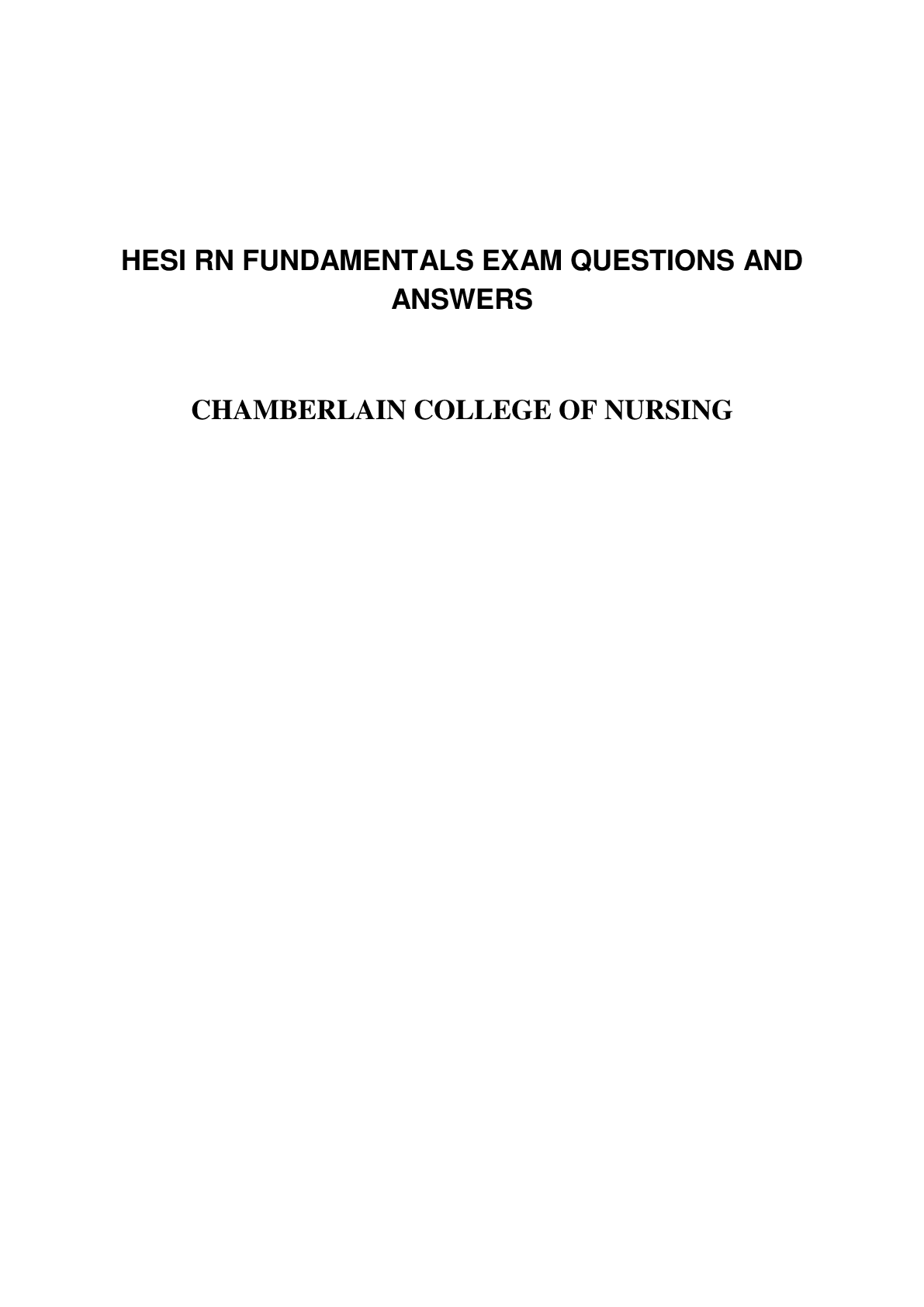
Buy this document to get the full access instantly
Instant Download Access after purchase
Buy NowInstant download
We Accept:

Reviews( 0 )
$19.00
Can't find what you want? Try our AI powered Search
Document information
Connected school, study & course
About the document
Uploaded On
Dec 30, 2020
Number of pages
36
Written in
Additional information
This document has been written for:
Uploaded
Dec 30, 2020
Downloads
0
Views
139





